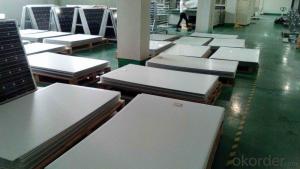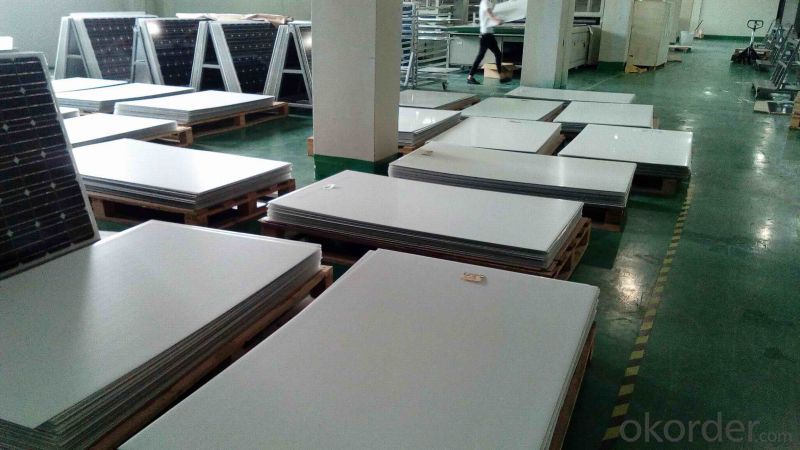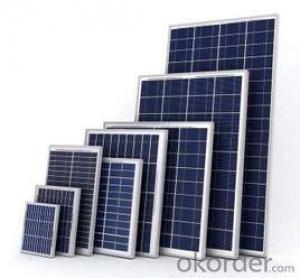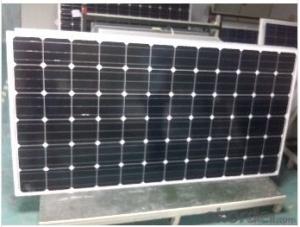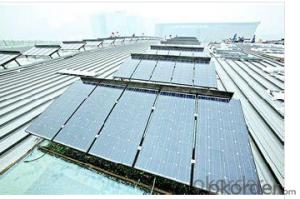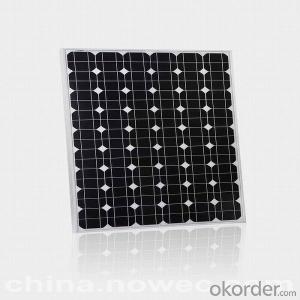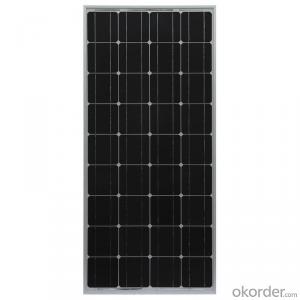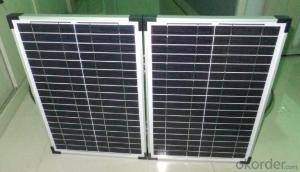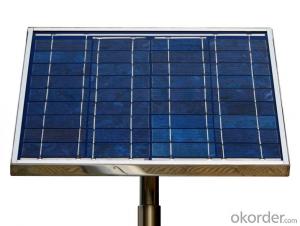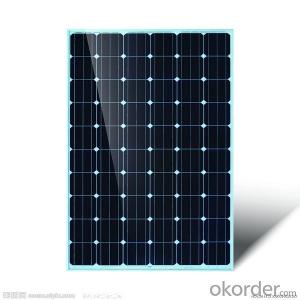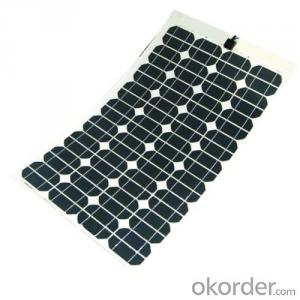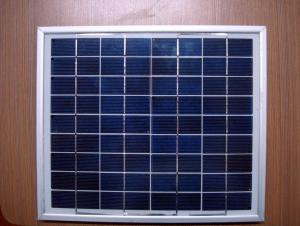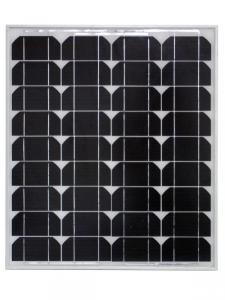80W High Efficiency Mono Solar Panels Made in China
- Loading Port:
- Shanghai
- Payment Terms:
- TT OR LC
- Min Order Qty:
- 1000 watt
- Supply Capability:
- 1000000 watt/month
OKorder Service Pledge
OKorder Financial Service
You Might Also Like
Specification
Product Description
Product Description
Solar module/panel with high efficiency solar cells
Strong, lightweight aluminum frame design with reinforced sealing and load hold to prevent freezing and warping, and stand against high wind.
Under Standard Test Conditions(STC): Irradiance of 1000W/m2, Am1.5 and 25º C cell temperature.
Mechanical Characteristics
Dimensions: 670mm(L) x 770mm(W) x 30mm(H)
Weight: 8.2kg
Solar Cells: Polycrystalline solar cells, 36 cells
Construction: Front: High-transmission 3.2mm tempered glass; Encapsulate: EVA; Back: TPT
Frame: Clear anodized aluminum alloy Color: Silver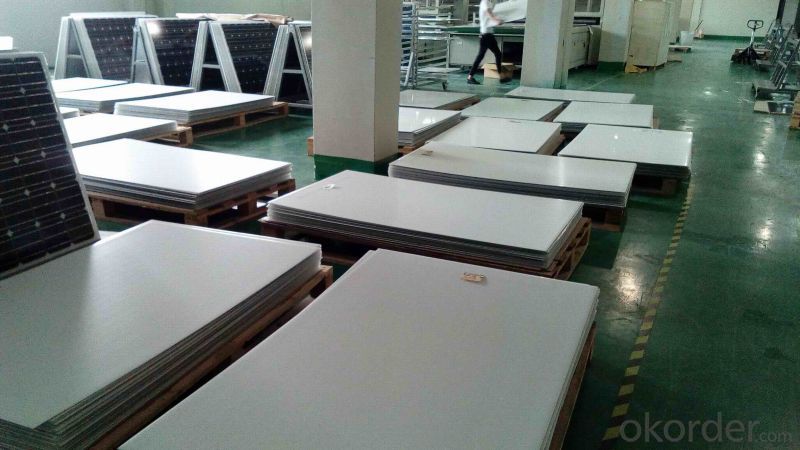
Product features:
1. The modules use high-quality imported polycrystalline or monocrystalline solar cells;
Enclosed by high-rigidity tempered glass, with excellent light transmittance and output performance;
2. Surface treated with reflection-reducing process, increasing the light absorption.
Back sealed with anti-aging EVA, resistant from moisture and corrosion.
3. The efficiency of our monocrystalline solar cell is over 17%, and polycrystalline panel is over 16%. We stipulate, the allowance of each panel's rated power has to be positive. Each panel is strictly tested before leaving the factory.
4. Our solar panel is designed with a lifetime of 25 years, and guaranteed that the power decline less than 10% within 10 years, and 20% within 20 years.
| Performance | |
| Rated Power[Pmax] | 80W |
| Power Tolerance | ± 3% |
| Nominal Voltage | 18V |
| Design Life | 25 years |
| Electrical Characteristics | |
| Maximum Power [Pmax] | 80W± 3% |
| Maximum Power Voltage [Vmp] | 18V± 3% |
| Maximum Power Current [Imp] | 4.65A± 3% |
| Short-Circuit Current [Isc] | 5.11A± 3% |
| Open-Circuit Voltage [Voc] | 21.05V± 3% |
| Current Temperature Coefficient | 0.08%/º C |
| Voltage Temperature Coefficient | - 0.32%/º C |
| Power Temperature Coefficient | -0.38%/º C |
- Q: I'm a carpenter, and can do electric work. I want to make some money installing Solar Panels. what's the best source?
- DRI Roofing. They are coming out with some of the best technology for solar panels. I know they have a different branch for the solar panel division, but i don't remember it right now.
- Q: I'm thinking of these solar panels that people have on their rooftops in domestic properties. I suppose I mean after how long do you break even with respect to just carrying on without them and getting you electricity from the utilities companies? Or answer in any way you think is pertinent. The more info the better.
- Why pay thousands of dollars for solar energy ($27,000 average cost) when you can build your own solar panel system for just a fraction of the retail cost. You can build a single solar panel or you can build an entire array of panels to power your whole house. Some people are saving 50% on their power bill, some people are reducing their bill to nothing. But what’s most impressive is that just by following these instructions some are even making the power company pay them!
- Q: Can solar panels be damaged by birds or rodents?
- Yes, solar panels can be damaged by birds or rodents. Birds may build nests underneath the panels or perch on them, causing potential damage to the wiring or scratching the surface. Rodents like squirrels or rats can chew on the wires, leading to electrical issues. Therefore, it is important to take preventive measures such as installing bird deterrents or protective barriers to minimize the risks posed by these animals.
- Q: I'm doing a project for school and I'm a little confused about energy and solar panels. I'm looking to propose installation of solar panels to power the computer lab at my school. From what I've read a computer and monitor use roughly 350 watts per hour. I was looking at solar panels and it says they produce various wattage. For example, I was looking at one rated at 200 watts. Does that mean 200 watts in a day? Or per hour? Please help.
- The rating of a solar panel is a maximum continuous rating. A 200 Watt panel will give a maximum of 200 watts under ideal conditions. A computer and monitor use about 400 Watts. not per hour - watts is Volts * Amps and a measure of Power. In hour a computer and monitor uses 400 Watt hours (Wh). Wh is a measure of Energy. To power a lab of 0 computers you will need 0* 400 = 4000 Watts. To run this from solar panels through the day only you would need a 4000 Watt panel. Except - its cloudy, the sun is in the wrong place - many factors reduce the output. To be reasonably safe you would need about a 2000 Watt panel. Then you would need batteries to store power through dull periods AND a voltage converter to change from low voltage DC from the solar panels to the mains voltage for your computers.
- Q: Can solar panels be installed on wearable devices?
- Yes, solar panels can be installed on wearable devices. However, due to the limited surface area available on wearables, the amount of energy generated may be relatively low compared to larger solar installations. Additionally, the efficiency of such panels may vary based on the device's orientation to the sun. Nonetheless, incorporating solar panels on wearables can contribute to extending battery life and enhancing their overall sustainability.
- Q: I mean when light hits the solar panel where does the energy go and what does it become? Be specific.
- I think you got half the answer, but basically like everyone else said, the light hits the electrons and create energy now that energy, since it is now an electrical energy is then saved within batteries connected to the solar panel and that provides the power itself, so as long as there is sun, the batteries will charge up, once the sun goes away, the batteries slowly deplete, but once the sun hits, more energy. =)
- Q: Our school is in the process of being built, but they have no plans to include any environmental benefits. I was wondering how to get a grant for solar panels (at least) or who I can talk to in order to get a grant.
- it quite is attending to be a actual crutch for Republicans isn't this? Cuts in those Bush era very own loan assure courses won't cover / 4 of the expenditures of in simple terms Irene on my own so shall we toss that argument out interior the trash, the place it belongs. this is devoid of going into the expenditures of the Midwest tornadoes, the fires in Texas and their drought, the fires in New Mexico, and the earthquake interior the Mid Atlantic. And greater to come again. in no way formerly in our historic past have we demanded that catastrophe alleviation for our human beings be tied to cuts in courses, and once you're honest, you will see that many different courses are on their slicing block too, lots of them an identical ones they tried to ram down our throats final time they dug of their heels, and seem how super that became out...our credit status went down. Are they loopy to choose greater?
- Q: Does San Francisco get enough sunshine to really make solar panels a viable option for creating a self-supporting home? Certainly a wind turbine would be a good source of energy, but what about solar panels? Does S.F. get enough sunshine to justify using solar panels? It's overcast a lot in the Bay Area, are there any solar panels better than others for a climate like this?
- Yes, San Francisco gets enough sunshine. That will vary depending on your site location, some are better than others. The best way to find out how much electricity your specific location can generate is to get a quote from a solar company. I am in the process of getting PV's installed on my home in the Sacto area and got quotes from 3 companies. My home is in a good, not optimal possition and depending on where on the roof I place the panels my efficiency will vary. Also depending on the brand of panels, some will take less square footage on the roof to produce the same amount of electricity. The price on all 3 were very close to each other. All 3 companies I dealt with gave a no cost/no obligation quote, and they were are very knowledgeable about the specific utility rebates I would be eligable for. I say it is well worth the time to check it out. My system should be going onto my roof in just a few more weeks. I was able to get nearly 50% of my cost refunded by my utitlity, plus my federal tax rebate. My system should be paid for in about 6 years.
- Q: Im doing this project on Solar panels and im not so sure what they are!some questions i have are who invented them and what were they invented? If u could know anything on Solar Panels i would love to hear it. Thanks!!!!!!!!!!!!!!!!!!!!!
- Solar power is harnessed through solar panels. These solar panels consist of numerous solar cells. That helps in producing the electricity
- Q: I just connected my 5 Watt 2V solar panel directly to my 300 Watt 2 inverter. It worked for about 2 minutes then it popped (sparks, smoke etc)! What the hell did I do wrong? I thought the solar panel was 2 volts? Can someone with experience with these things help me out?
- An 300W inverter will draw 25 amps from a car battery but the solar panel will only produce about 4 amps. By drawing too much power with the inverter you lowered the voltage so much in the panels wiring that the amp rating on the internal wiring was exceeded and they melted. Next, time run the panel to a voltage regulator, then the regulator to a car battery, then the battery to the inverter.
Send your message to us
80W High Efficiency Mono Solar Panels Made in China
- Loading Port:
- Shanghai
- Payment Terms:
- TT OR LC
- Min Order Qty:
- 1000 watt
- Supply Capability:
- 1000000 watt/month
OKorder Service Pledge
OKorder Financial Service
Similar products
Hot products
Hot Searches
Related keywords
